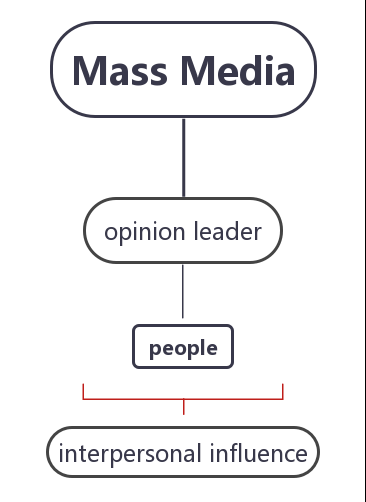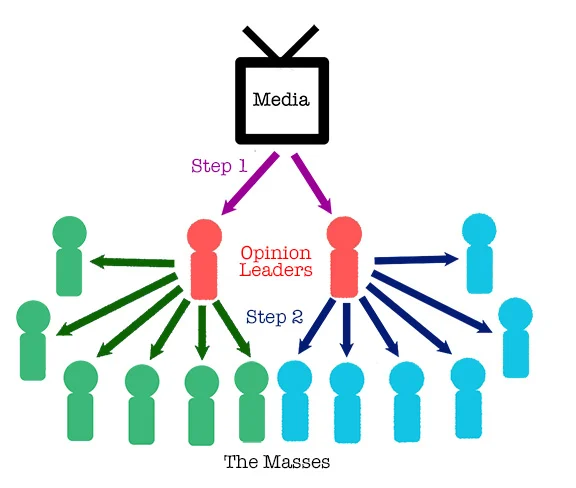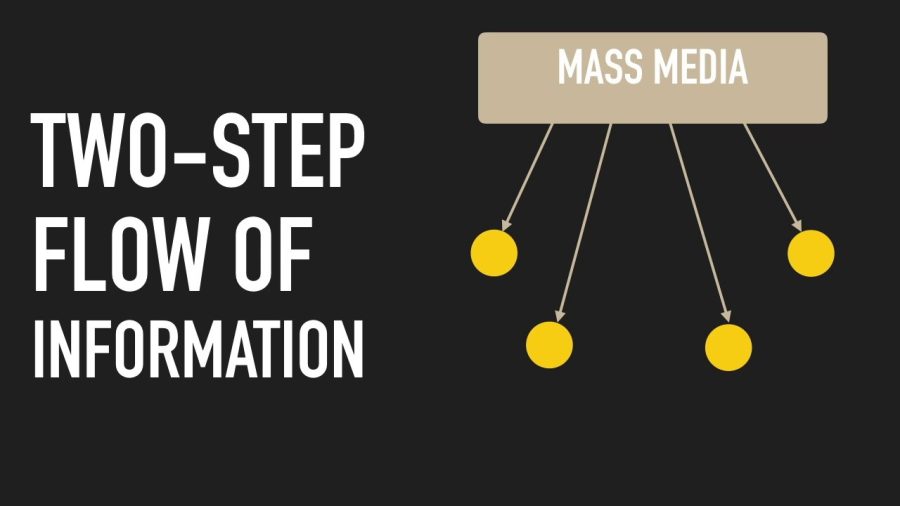What is two step flow theory
In the Two-Step Flow Theory, media messages affect opinion leaders first, who then influence people in their social group. It shows how personal communication plays a big role in shaping what the public thinks.
Opinion leaders in the context of this theory, and the role they play
Opinion leaders, as per the Two-Step Flow Theory, are individuals who have a big impact on how others think, act, and see things. These folks are really into consuming media, know a lot, and are seen as experts in certain topics. They’re like the go-betweens connecting regular people with the mass media. Opinion leaders affect what people believe and decide by explaining, filtering, and passing on media messages to others. The heart of the Two-Step Flow Theory is all about how these opinion leaders influence everyone else.

Two-Step Flow Theory challenging the traditional view of direct media influence on the general public
The Two-Step Flow Theory shakes up the traditional idea that media directly shapes what everyone thinks. Instead, it suggests that media messages go to opinion leaders first, who then share them with others. This challenges the usual belief that media has a direct impact on what most people think. It’s like having a middle person between the media and the public. This makes us question whether media really affects people directly and uniformly, highlighting how talking to others and influential people play a big role in shaping what we believe and how we act.
Key factors that determine the influence of opinion leaders
According to the Two-Step Flow Theory, several crucial factors impact how opinion leaders influence others. Firstly, an opinion leader’s impact hinges on their credibility and expertise in a specific field. If others perceive them as reliable and knowledgeable, their influence is stronger. Secondly, the closeness of the relationship between the opinion leader and those they influence is vital. Close, personal connections have a more significant impact compared to distant relationships. Additionally, the relevance of the topic being discussed is key. People are more likely to be influenced if the topic is interesting to them. Lastly, the cultural and socioeconomic background of both the opinion leader and the audience also plays a role in shaping influence. Similar backgrounds can enhance the effectiveness of opinion leaders in the Two-Step Flow Theory.

The implications of the Two-Step Flow Theory for advertising and marketing strategies
The Two-Step Flow Theory significantly affects how advertising and marketing strategies are shaped. By understanding the role of opinion leaders, marketers can better target their efforts. Instead of solely relying on mass media, they can engage with influential opinion leaders specific to their target audience. By gaining the support of these influential individuals, advertisers can indirectly reach a larger audience. This approach emphasizes the importance of personal connections and trust, which often have a stronger impact than direct media messages. It underscores the value of word-of-mouth marketing and building relationships with influential individuals, transforming how marketing campaigns are developed to appeal to a broader consumer base.
Criticism or limitations associated with the Two-Step Flow Theory
The Two-Step Flow Theory has a few issues. It might be too simple, not capturing how people really form opinions. In today’s digital age with social media, it doesn’t quite fit with the way we access information from various sources. Plus, it doesn’t recognize that people can be leaders and followers at different times. Also, it misses the bigger influences like politics and culture on what people think.



I think this blog is very well written and clearly explains what the two-step flow theory is. My blog is written on the same topic! The blog discusses some of the limitations and criticisms of the two-step flow theory, which can help to think deeply about the complexities of facing society.
Overall, this blog helped me to understand the theory better and also mentioned the limitations of the theory, which helped me to look at things from multiple perspectives.
Very Informative post, it was really great to read! The pictures added in the blog were very easy to even further understand your viewpoints. It was a very well structured post, really enjoyed it.
good article’╝īgood pics’╝īit really help
This blog post has provided me with a clear understanding of the Two-Step Flow Theory. It has been incredibly helpful!
Great!Your blog post was informative and visual with diagrams .I liked the fact that you spoke about the implications of the two step flow theory .Who was the two step flow theory developed by?